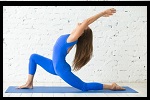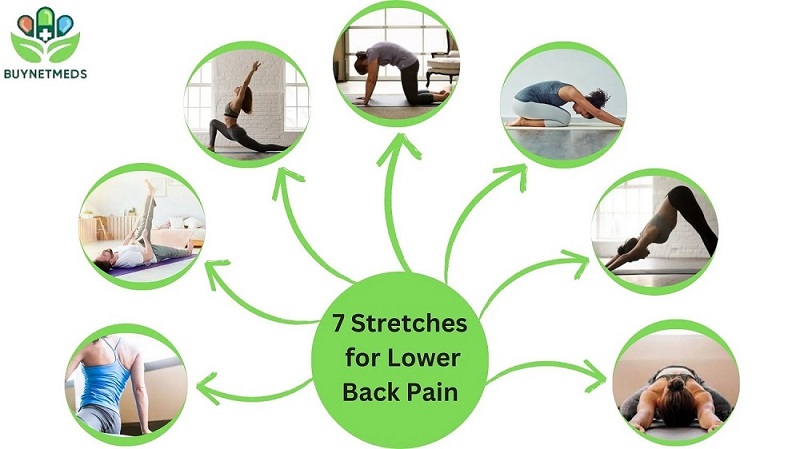1) Marjariasana / cat-cow pose
 Marjariasana, commonly known as the Cat-Cow Pose, is a fundamental posture in yoga that consists of two distinct movements: Cat Pose (Marjaryasana) and Cow Pose (Bitilasana). This dynamic sequence is designed to improve spinal flexibility, enhance core strength, and promote relaxation. It is an excellent practice for both beginners and experienced yogis, offering numerous physical, mental, and emotional benefits.
Marjariasana, commonly known as the Cat-Cow Pose, is a fundamental posture in yoga that consists of two distinct movements: Cat Pose (Marjaryasana) and Cow Pose (Bitilasana). This dynamic sequence is designed to improve spinal flexibility, enhance core strength, and promote relaxation. It is an excellent practice for both beginners and experienced yogis, offering numerous physical, mental, and emotional benefits.
What are the health benefits of cat-cow pose?
1. Improves Spine Flexibility and Mobility
One of the most prominent benefits of the Cat-Cow Pose is its ability to enhance spinal flexibility. By moving the spine through its full range of motion, this sequence helps to lubricate the vertebrae and maintain healthy spinal discs. This increased flexibility can aid in reducing back stiffness and discomfort.
2. Strengthens and Stretches Core Muscles
The rhythmic motion of Cat-Cow Pose actively engages the core muscles, including the abdominals, obliques, and lower back muscles. Strengthening these muscles helps to support the spine and improve overall posture. Additionally, stretching the abdominal muscles can relieve tension and promote a feeling of openness in the front body.
3. Enhances Coordination and Balance
Practicing Cat-Cow Pose enhances neuromuscular coordination. The synchronization of breath with movement requires focus and precision, thereby improving overall balance and body awareness. This coordination is beneficial not only in yoga but also in daily activities that require controlled movement.
4. Alleviates Back Pain
Regular practice of Cat-Cow Pose can be particularly beneficial for individuals suffering from chronic back pain. The gentle spinal movements help to release tension in the back muscles and promote relaxation. By improving spinal alignment, this pose can also reduce the strain on the lower back.
5. Boosts Circulation
The undulating motion of the Cat-Cow sequence stimulates blood circulation throughout the body. This increased circulation helps to deliver oxygen and nutrients to the muscles and joints, promoting overall vitality and aiding in the removal of metabolic waste
Mental and Emotional Benefits of Cat-Cow Pose
1. Reduces Stress and Anxiety
The Cat-Cow Pose is known for its calming effects on the mind. The combination of deep, rhythmic breathing and gentle movement helps to activate the parasympathetic nervous system, which is responsible for promoting relaxation. This activation can lead to reduced levels of stress and anxiety.
2. Improves Focus and Concentration
By coordinating breath with movement, Cat-Cow Pose encourages mindfulness. This mindfulness practice helps to center the mind, improving focus and concentration. This enhanced mental clarity can be beneficial in both personal and professional settings.
3. Enhances Emotional Stability
The Cat-Cow Pose can also contribute to emotional balance. The movement helps to release stored emotions and tension in the body, particularly in the hips and lower back, which are common areas where stress is held. This release can lead to a greater sense of emotional well-being and stability.
How to Do the Cat-Cow Pose Properly
Preparation for Cat-Cow Pose
1. Find a Comfortable Space:
Select a quiet, clean space with a yoga mat to provide cushioning for your knees and hands. Ensure the area is free of distractions so you can focus on your practice.
2. Warm Up:
If you are new to yoga or feeling particularly stiff, spend a few minutes warming up with some gentle stretches or a brief walk to prepare your body for movement.
Tips for a Deeper Practice
1. Focus on Breath:
Emphasize deep, mindful breathing to enhance the meditative aspect of the pose. Use your breath to guide each movement, creating a rhythmic flow.
2. Engage Your Core:
Keep your core muscles engaged throughout the sequence to support your spine and improve stability. This engagement also enhances the stretch and strengthens the abdominal muscles.
3. Move Slowly and Mindfully:
Take your time with each transition, moving slowly and mindfully. This deliberate pace helps to prevent injury and allows you to fully experience the benefits of each pose.
4. Use Props if Needed:
If you have wrist or knee discomfort, consider using props such as a folded blanket under your knees or a yoga wedge under your hands for added support.
5. Listen to Your Body:
Pay attention to how your body feels during the practice. Avoid pushing into any discomfort or pain, and make adjustments as needed to maintain a comfortable and safe practice.
2) Adho Mukha Svanasana / Dog Pose

Adho Mukha Shvanasana, commonly known as the Downward-Facing Dog Pose, is one of the most iconic and frequently practiced poses in yoga. This inversion posture is essential for building strength, increasing flexibility, and promoting overall wellness. Recognized for its ability to stretch the entire body and calm the mind, Adho Mukha Shvanasana is suitable for yogis of all levels
Health Benefits of Adho Mukha Shvanasana
1. Full-Body Stretch
Adho Mukha Shvanasana provides a full-body stretch, targeting multiple muscle groups simultaneously. It stretches the hamstrings, calves, shoulders, and spine, promoting overall flexibility and mobility.
2. Strengthens Muscles
This pose helps to strengthen the arms, shoulders, and legs. By supporting your body weight in an inverted position, you engage and build strength in these muscle groups.
3. Improves Circulation
The inversion aspect of Downward-Facing Dog promotes blood circulation. It encourages blood flow to the brain, which can help to enhance mental clarity and relieve headaches.
4. Relieves Stress and Anxiety
Adho Mukha Shvanasana is known for its calming effects on the nervous system. The pose encourages deep, mindful breathing, which can reduce stress and anxiety levels, promoting a sense of relaxation and well-being.
Tips for a Deeper Practice
1. Engage Core Muscles
A strong core is essential for a deep and stable Adho Mukha Shvanasana. Engaging your core muscles supports your spine and helps distribute the effort required to hold the pose across your entire body.
2. Focus on Breath
Incorporating focus breath control into your practice can further enhance core engagement. Inhale deeply, expanding your ribcage and filling your lungs completely. On the exhale, draw your navel towards your spine and maintain this engagement throughout your breaths. This practice not only strengthens your core but also fosters a deeper connection between your breath and body.
3. Consistent Practice
Regular practice of Adho Mukha Shvanasana will improve your strength and flexibility over time. Consistency is key to experiencing the full benefits of the pose
3) Balasana stretch / child’s pose
 The Balasana stretch, commonly known as Child’s Pose, is a fundamental yoga posture celebrated for its simplicity and effectiveness. This pose offers a myriad of benefits, making it an essential component of any yoga routine. In this comprehensive guide, we will delve into the numerous advantages of the Balasana stretch, provide detailed instructions on how to perform it correctly, and explore various modifications and variations to suit all fitness levels.
The Balasana stretch, commonly known as Child’s Pose, is a fundamental yoga posture celebrated for its simplicity and effectiveness. This pose offers a myriad of benefits, making it an essential component of any yoga routine. In this comprehensive guide, we will delve into the numerous advantages of the Balasana stretch, provide detailed instructions on how to perform it correctly, and explore various modifications and variations to suit all fitness levels.
Benefits of the Balasana Stretch
1. Stretching and Flexibility
Balasana provides a deep stretch to the spine, hips, thighs, and ankles. By extending the arms forward and sinking the hips back towards the heels, practitioners can enhance the flexibility of these areas. This stretch is particularly beneficial for those with tight hip flexors and hamstrings, as it gently encourages the release of tension.
2. Spinal Alignment and Back Pain Relief
One of the primary physical benefits of Balasana is its ability to promote spinal alignment. As the body folds forward, the spine is gently elongated and decompressed, which can alleviate back pain and reduce the risk of spinal injuries. This makes it an excellent pose for individuals who suffer from chronic back issues or who spend long hours sitting.
3. Improved Digestion
Balasana also aids in improving digestion. The gentle pressure exerted on the abdomen during the forward fold helps to stimulate the digestive organs, promoting better digestion and relieving symptoms such as bloating and constipation. This makes it an effective pose for enhancing overall gut health.
How to Perform the Balasana Stretch
1. Start in a Kneeling Position
Begin by kneeling on the floor. Bring your big toes together and sit back on your heels. Your knees can be together or spread apart, depending on what feels most comfortable for you.
2. Fold Forward
As you exhale, gently fold your torso forward, bringing your chest towards your thighs. Extend your arms in front of you with palms facing down or rest them alongside your body with palms facing up.
3. Rest Your Forehead on the Floor
Lower your forehead to the mat. If your forehead does not comfortably reach the floor, place a block or a folded blanket under it for support.
4. Relax and Breathe
Allow your entire body to relax. Close your eyes and focus on your breath. Take slow, deep breaths, feeling the stretch in your spine, hips, and thighs. Hold this position for several breaths or as long as you feel comfortable.
Common Mistakes to Avoid Balasana Stretch
1. Incorrect Knee Position
Mistake: Knees Too Close Together or Too Far Apart
Having the knees too close together can limit the range of motion and make it difficult to fold forward comfortably. Conversely, having the knees too far apart can strain the hips and lower back.
Solution:
Find a comfortable knee position that allows your torso to rest between your thighs. Experiment with different distances to see what works best for your body. Generally, keeping the knees hip-width apart is a good starting point.
2. Improper Head Support
Mistake: Straining the Neck
Allowing the head to hang unsupported can strain the neck muscles, leading to discomfort and tension.
Solution:
Ensure that your forehead is resting comfortably on the mat, a block, or a folded blanket. This support helps maintain proper neck alignment and promotes relaxation.
3. Arm Position Issues
Mistake: Tension in the Shoulders
Keeping the arms rigid or tensed can lead to unnecessary strain in the shoulders and upper back.
Solution:
Relax your arms and let them rest naturally. You can extend them forward with palms down for a deeper shoulder stretch or place them alongside your body with palms up for a more restorative version.
4. Lack of Proper Breathing
Mistake: Shallow or Erratic Breathing
Neglecting to focus on your breath can reduce the calming and restorative benefits of Balasana.
Solution:
Practice deep, rhythmic breathing. Inhale deeply through your nose, allowing your abdomen to expand, and exhale slowly. This breathing technique helps calm the mind and enhances the stretch.
5. Forcing the Stretch
Mistake: Pushing Too Hard
Forcing your body into the pose can lead to discomfort or injury, particularly in the lower back, hips, and knees.
Solution:
Approach Balasana gently. Allow your body to fold naturally without forcing. Use props like blankets or blocks to support your body and make the pose more comfortable.
4) Ardha Matsyendrasana / Seated Twist Stretch
 The Seated Twist Stretch, also known as Ardha Matsyendrasana in yoga, is a fundamental posture that offers significant benefits for flexibility, digestion, and spinal health. This twist pose is widely appreciated for its ability to release tension and improve mobility. In this extensive guide, we will explore the advantages of the Seated Twist Stretch, provide detailed steps on how to perform it correctly, and discuss various modifications and variations to suit all fitness levels.
The Seated Twist Stretch, also known as Ardha Matsyendrasana in yoga, is a fundamental posture that offers significant benefits for flexibility, digestion, and spinal health. This twist pose is widely appreciated for its ability to release tension and improve mobility. In this extensive guide, we will explore the advantages of the Seated Twist Stretch, provide detailed steps on how to perform it correctly, and discuss various modifications and variations to suit all fitness levels.
Benefits of the Seated Twist Stretch
1. Enhanced Spinal Flexibility
One of the most significant advantages of the Seated Twist Stretch is the improvement in spinal flexibility. This pose encourages the spine to move in a rotational manner, which can help maintain or increase the range of motion in the vertebrae. Regular practice can alleviate stiffness and improve overall spinal health.
2. Improved Digestion
The twisting motion of the Seated Twist Stretch massages the internal organs, particularly those involved in digestion. This gentle compression and release can stimulate the digestive tract, helping to improve digestion and alleviate issues such as bloating and constipation. By promoting healthy digestion, this pose supports overall gut health.
3. Detoxification
Twisting poses like the Seated Twist Stretch aid in detoxifying the body. The compression of the abdominal organs during the twist helps to stimulate the liver and kidneys, enhancing their ability to filter and eliminate toxins from the body. This detoxifying effect can lead to increased energy levels and improved overall health.
4. Relief from Back Pain
For individuals suffering from back pain, the Seated Twist Stretch can provide significant relief. The gentle rotation helps to release tension in the muscles surrounding the spine, particularly in the lower back. By reducing muscle stiffness and improving spinal alignment, this pose can alleviate discomfort and prevent future back issues.
5. Improved Posture
Regular practice of the Seated Twist Stretch can lead to better posture. This pose encourages the practitioner to sit up straight with an elongated spine, promoting awareness of proper alignment. Improved posture not only enhances physical appearance but also reduces the risk of musculoskeletal issues.
Mental and Emotional Benefits of the Seated Twist Stretch
1. Stress Reduction
The Seated Twist Stretch is known for its stress-relieving properties. The combination of deep, rhythmic breathing and gentle spinal rotation helps to activate the parasympathetic nervous system, inducing a state of calm and relaxation. This makes it an excellent pose for reducing anxiety and mental fatigue.
2. Enhanced Focus and Clarity
Practicing the Seated Twist Stretch requires concentration and mindfulness, which can improve mental focus and clarity. By directing attention to the breath and the sensations in the body, practitioners can cultivate a sense of presence and awareness, leading to enhanced cognitive function and mental clarity.
3. Emotional Balance
The Seated Twist Stretch can also promote emotional balance. The physical act of twisting can symbolize the release of negative emotions and stress, helping individuals to let go of emotional baggage. This can lead to a greater sense of emotional well-being and stability.
How to Perform the Seated Twist Stretch
Step-by-Step Instructions
1.Sit on the floor: Begin by sitting on the floor with your legs extended in front of you.
2.Bend one knee: Bend your right knee and place your right foot on the outside of your left thigh.
3.Twist your torso: Inhale, lengthen your spine, and then exhale as you twist your torso to the right. Place your left elbow on the outside of your right knee and your right hand on the floor behind you for support.
4.Hold the pose: Hold the twist for several breaths, focusing on deep, steady breathing. Inhale to lengthen your spine and exhale to deepen the twist.
5.Repeat on the other side: Release the twist and repeat on the opposite side
Common Mistakes to Avoid
To ensure you perform the Seated Twist Stretch safely and effectively, avoid these common mistakes:
1. Holding the Breath
Breathe deeply and steadily. Holding your breath can increase tension and reduce the benefits of the stretch.
2. Rounding the Back
Maintain a straight spine throughout the pose. Rounding your back can reduce the effectiveness of the twist and lead to discomfort.
5) Hamstring stretch
 Understanding the Importance of Hamstring Health:
Understanding the Importance of Hamstring Health:
Hamstrings, though often overlooked, play a crucial role in our daily lives. These muscles, located at the back of the thigh, are responsible for various movements, including bending the knee and extending the hip. Yet, they are frequently neglected in exercise routines, leading to tightness and potential injuries. In this comprehensive guide, we delve deep into the significance of hamstring stretching and how it can unlock a myriad of benefits for your overall health and well-being.
Benifit of Hamstring stretch
Enhancing Flexibility and Range of Motion
One of the primary benefits of hamstring stretching is the improvement in flexibility and range of motion. As we age or engage in activities that involve sitting for prolonged periods, our hamstrings tend to become tight and less flexible. This tightness can restrict movement and increase the risk of strains or tears. Regular stretching helps counteract this by lengthening the muscles and increasing their elasticity, allowing for greater freedom of movement.
1. Preventing Injuries and Alleviating Pain
Hamstring injuries are common, especially among athletes and individuals who participate in activities that require sudden bursts of speed or explosive movements. Incorporating hamstring stretching into your routine can significantly reduce the risk of such injuries by improving muscle flexibility and strength. Additionally, for those already experiencing hamstring-related pain or discomfort, targeted stretching exercises can provide relief by releasing tension and promoting healing.
2. Improving Athletic Performance
Athletes, in particular, can benefit greatly from incorporating hamstring stretching into their training regimen. Flexible hamstrings contribute to better performance in various sports, including running, soccer, basketball, and gymnastics. By increasing flexibility and range of motion, athletes can achieve greater speed, agility, and power, ultimately enhancing their overall athletic performance.
3. Promoting Better Posture and Balance
The health and flexibility of the hamstrings are closely linked to posture and balance. Tight or shortened hamstrings can pull the pelvis out of alignment, leading to poor posture and back pain. By regularly stretching these muscles, you can help maintain proper alignment of the spine and pelvis, which in turn promotes better posture and reduces the risk of chronic pain. Moreover, improved balance is essential for preventing falls and injuries, especially as we age.
6) Anjaneyasana ( Low lunge Pose)

Anjaneyasana, also known as the Low Lunge Pose, is a fundamental yoga posture that offers numerous benefits for both the mind and body. This powerful asana, named after the Hindu deity Hanuman, plays a pivotal role in enhancing flexibility, strengthening muscles, and promoting mental clarity. In this comprehensive guide, we will delve deep into the practice, benefits, variations, and tips for mastering Anjaneyasana.
Benefits of Anjaneyasana
1. Enhanced Flexibility: Anjaneyasana is renowned for its ability to stretch and open the hip flexors, quadriceps, and hamstrings. This increased flexibility can alleviate tightness and improve range of motion in the hips and legs.
2. Strength Building: This pose strengthens the muscles in the legs, glutes, and core. Engaging these muscles during the pose helps build endurance and stability.
3. Improved Posture: Regular practice of Anjaneyasana encourages proper alignment of the spine and pelvis. This alignment is crucial for maintaining good posture and preventing back pain.
4. Stress Relief: Like many yoga poses, Anjaneyasana promotes relaxation and stress relief. The deep stretch and controlled breathing involved in the pose help calm the mind and reduce anxiety.
5. Enhanced Balance: Balancing in the Low Lunge Pose improves overall stability and coordination. This can be particularly beneficial for athletes and individuals seeking to improve their physical performance.
Step-by-Step Guide to Performing Anjaneyasana
Step 1: Starting Position
Begin in a tabletop position on your hands and knees. Ensure that your wrists are directly under your shoulders and your knees are under your hips.
Step 2: Transition to Low Lunge
Step your right foot forward between your hands, aligning your right knee above your right ankle. Slide your left leg back, extending it fully and resting the top of your foot on the mat.
Step 3: Align and Engage
Square your hips forward, ensuring that they are level. Engage your core muscles to support your lower back and maintain balance. Keep your gaze forward or slightly upward.
Step 4: Lift and Lengthen
On an inhale, lift your torso upright and raise your arms overhead. Your palms can face each other or be joined together. Lengthen through your spine and reach your fingertips toward the ceiling.
Step 5: Deepen the Stretch
Sink your hips deeper into the lunge, feeling a stretch along the front of your left thigh and hip flexor. Keep your right knee aligned with your right ankle and avoid letting it extend past your toes.
Step 6: Hold the Pose
Hold Anjaneyasana for several breaths, maintaining steady and deep inhalations and exhalations. Focus on lengthening through your spine and deepening the stretch with each breath.
Step 7: Release and Repeat
To release, lower your hands back to the mat and step your right foot back to return to the tabletop position. Repeat the pose on the opposite side, stepping your left foot forward this time.
Common Mistakes and How to Avoid Them
1. Knee Misalignment: Ensure that your front knee is directly above your ankle and not extending past your toes. This alignment protects your knee joint from strain.
2. Hips Not Square: Keep your hips level and square to the front. Avoid letting one hip drop or rotate out of alignment. Engage your core to help maintain this position.
3. Arching the Lower Back: While it’s important to lengthen through the spine, avoid overarching the lower back. Engage your abdominal muscles to support your lower spine and prevent compression.
4. Forgetting to Breathe: Deep, controlled breathing is essential in yoga. Focus on maintaining a steady breath throughout the pose to enhance relaxation and deepen the stretch.
7) Setu Bandhasana / Bridge pose
 Setu Bandhāsana, also known as the Bridge Pose, is a foundational asana in yoga that offers a myriad of benefits for both the body and mind. This posture not only strengthens the back and glutes but also promotes relaxation and mental clarity. Originating from the Sanskrit words “Setu” (bridge) and “Bandha” (lock), this pose symbolizes the bridging of physical strength and mental serenity.
Setu Bandhāsana, also known as the Bridge Pose, is a foundational asana in yoga that offers a myriad of benefits for both the body and mind. This posture not only strengthens the back and glutes but also promotes relaxation and mental clarity. Originating from the Sanskrit words “Setu” (bridge) and “Bandha” (lock), this pose symbolizes the bridging of physical strength and mental serenity.
Benefits of Practicing Setu Bandhāsana
Physical Benefits
Strengthens the Back and Glutes: Regular practice of Setu Bandhāsana helps in building strength in the spine, buttocks, and hamstrings. The lifting motion engages the lower body muscles, providing a robust workout for these areas.
Stretches the Chest and Shoulders: This pose opens up the chest, improving respiratory function and promoting better lung capacity. It also stretches the shoulders, alleviating tension and stiffness.
Improves Digestion: By stimulating the abdominal organs, Setu Bandhāsana aids in better digestion and helps alleviate common digestive issues such as constipation.
Enhances Flexibility: The backward bend in this pose enhances the flexibility of the spine, making it more supple and resilient.
Mental and Emotional Benefits
Reduces Stress and Anxiety: The gentle inversion in Setu Bandhāsana calms the nervous system, reducing stress and anxiety levels. It is especially beneficial for individuals dealing with high-stress environments.
Improves Mood: This pose increases blood circulation, which in turn boosts the release of endorphins, the body’s natural mood lifters.
Promotes Relaxation: The bridge pose is known for its calming effects, making it an excellent posture for winding down after a hectic day




